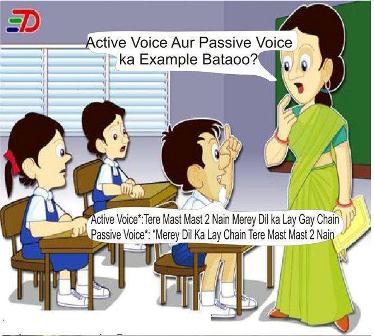A pic was shared like crazy on Facebook in the last few weeks—

This comic is factually incorrect, but it’s a good demonstration of how most people are confused about what actual Active and Passive voice is, and mostly just assume it to be random rearrangement of words.
In the comic, the teacher asks the students to give examples of Active Voice and Passive Voice. The smartass kid replies with two lines from the song _Tere mast mast do nain_ from the movie Dabangg, thereby also complimenting his teacher’s eyes.
There’s enough in this comic to make it viral, and viral it became, so I thought I would write a post about the actual grammatical stuff at work here.
To begin with, it has nothing to do with Active or Passive voice. The song lines demonstrate rearrangement (in this case, fronting) of the Verb Phrase. There’re multiple rearrangements here to suit the meter and rhyme, but the two lines are contrasted by the fronting of the entire Verb Phrase mere dil ka chain le gaye. The canonical word order would be—
“Tere do mast mast nain mere dil ka chain le gaye.”
The position of the object ‘chain’ has been changed and it’s been sent to the end of the sentence to get the Verb Phrase “mere dil ka le gaye chain”. This entire phrase is then fronted and placed in the beginning, to get
“Mere dil ka le gaye chain, tere mast mast do nain”.
Note that this has nothing to do with the Passive Voice. The song lyric in Passive Voice would be:
“Mere dil ka chain tere do mast mast nainon ke dwaara le jaaya gaya”, which is decidedly unromantic.
